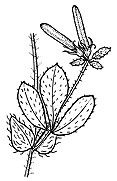Common name: Hairy Birds-foot Trefoil
Lotus subbiflorus Lag. APNI* Synonyms: Lotus suaveolens Pers. APNI*
Lotus hispidus Desf. ex DC. APNI*

Description: Procumbent or ascending annual or perennial herb to 60 cm high, much-branched; stems pilose.
Leaves with 5 leaflets, narrow-obovate to lanceolate, 5–20 mm long, 3–10 mm wide, lower 2 usually smaller and ± cordate, hairy.
Umbels mostly 2–4-flowered; peduncle to 25 mm long, elongating in pod, far exceeding the leaves. Calyx c. 5 mm long, pilose. Corolla 6–8 mm long, yellow; standard obovate; keel narrow and bent upwards from near base with a long straight tipped beak.
Pod terete, 6–15 mm long, 1.5–2 mm diam.; seeds usually 6–12, yellow to brown.
Distribution and occurrence: Native of Medit. region. Widespread in pastures and grasslands.
NSW subdivisions: *NC, *CC, *SC, *CT, *ST
Other Australian states: *Qld *Vic. *S.A.
This species is variable in habit, size of leaflets and indumentum. Several specimens previously identified as L. suaveolens and L. hispidus have been redetermined by D. Sokoloff as L. subbiflorus. We are tentatively assuming that all NSW material of these species will, in fact, belong to L. subbiforus.
Text by E. H. Norris & G. J. Harden
Taxon concept: Flora of NSW 2 (1991)
APNI* Provides a link to the Australian Plant Name Index (hosted by the Australian National Botanic Gardens) for comprehensive bibliographic data
***The AVH map option provides a detailed interactive Australia wide distribution map drawn from collections held by all major Australian herbaria participating in the Australian Virtual Herbarium project.
|


